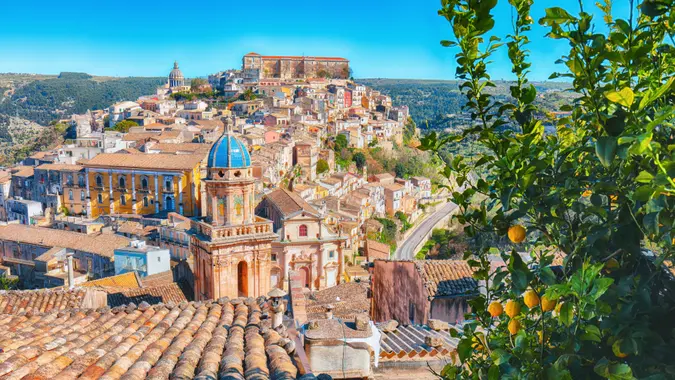You Can Live Well — as Low as $1K a Month — in These 7 Places in Italy

Commitment to Our Readers
GOBankingRates' editorial team is committed to bringing you unbiased reviews and information. We use data-driven methodologies to evaluate financial products and services - our reviews and ratings are not influenced by advertisers. You can read more about our editorial guidelines and our products and services review methodology.

20 Years
Helping You Live Richer

Reviewed
by Experts

Trusted by
Millions of Readers
Moving to Italy for retirement might sound like an expensive dream, but a report from International Living shows it’s more affordable than you might think. There are seven regions across the country where retirees can comfortably live for as little as $1,000-$1,700 monthly (well within reach of typical Social Security benefits).
This stands in sharp contrast to the U.S., where households over 65 spend an average of $4,345 monthly while Social Security pays only around $2,000. The math simply doesn’t work for many American retirees, making Italy’s affordable regions an attractive alternative to similar but more expensive European destinations.
The Most Affordable Italian Regions for Retirees
Abruzzo tops the affordability list at just $1,000-$1,200 monthly for singles. Located between the Apennine Mountains and Adriatic coast, this region has it all: mountain views, beach access and authentic Italian culture without tourist crowds. Small towns have rentals as low as $200 monthly, while entire countryside homes sell for under $50,000.
Sicily follows closely at $1,100-$1,300 for singles. The island’s warm climate, rich history and growing expat community make it appealing beyond just cost savings. Modern apartments in Palermo rent for around $570, while some towns still have those famous one-euro home programs.
Puglia, the boot heel of Italy, costs $1,110-$1,300 monthly and delivers the Mediterranean lifestyle most people imagine when thinking about Italian retirement. Towns like Lecce and Ostuni offer authentic experiences, with home purchases starting around $50,000 and rentals under $800.
Le Marche bills itself as “Tuscany without the crowds” for $1,200-$1,400 monthly. Medieval towns and Renaissance art means there’s tons of culture at your doorstep, while coastal areas are perfect for beach living. Two-bedroom apartments rent from $500 in places like Ascoli Piceno.
Umbria, Italy’s “Green Heart,” costs $1,400-$1,600 for singles. Central location means easy access to Rome and Florence, while rental apartments start at $410 monthly. The region’s festivals and cultural events rival more expensive neighbors.
Tuscany requires a higher budget of $1,500-$1,700, but avoiding expensive cities like Florence makes the famous region accessible. Towns like Arezzo and Pistoia are the classic Tuscan experience at reasonable costs, with apartments under $600 monthly.
Liguria, along the Italian Riviera, costs $1,500-$1,700 and has mild winters and excellent public transportation. Two-bedroom apartments in coastal cities start under $1,000 monthly.
The Practical Benefits Beyond Cost
Italy’s national healthcare system ranks among the world’s best and costs very little for residents. Many regions have modern hospitals and efficient medical care that often exceeds American standards.
The Elective Residency Visa makes legal residency straightforward for retirees with stable income around $33,000 annually. After five years, permanent residency becomes possible, with citizenship available after 10 years.
Daily life costs remain remarkably low across these regions. Cappuccinos cost $1.30 to $3, restaurant meals for two range from $20 to $90 depending on the region and fresh market produce costs significantly less than American grocery stores.
The Reality Check
While these cost estimates are appealing, they assume a modest lifestyle focused on local activities rather than frequent international travel or luxe amenities. Many regions require cars for convenient transportation, adding to monthly expenses.
Healthcare coverage requires navigating Italian bureaucracy and obtaining proper residency status. Language barriers can complicate daily tasks, though many regions have growing English-speaking expat communities.
The visa requirements, while manageable, demand proof of income both consistent and passive, as well as navigating Italian immigration processes. This isn’t as simple as just buying a plane ticket and moving.
Making the Numbers Work
For American retirees whose Social Security brings in $1,500-$2,000 monthly, these Italian regions are genuine opportunities to live comfortably while preserving other retirement savings. The key is choosing regions that match both your budget and lifestyle preferences.
Nature lovers might prefer Abruzzo’s affordable (and gorgeous!) countryside, while beach lovers could choose stunning Sicily or picturesque Puglia. Cultural buffs might splurge slightly for Tuscany or Umbria’s Renaissance treasures.
The opportunity represents more than just cost savings; it’s about accessing a lifestyle that many Americans find impossible to afford at home. Fresh food, walkable communities, rich culture and quality healthcare become available at prices that make sense on a fixed income.
 Written by
Written by  Edited by
Edited by 

























